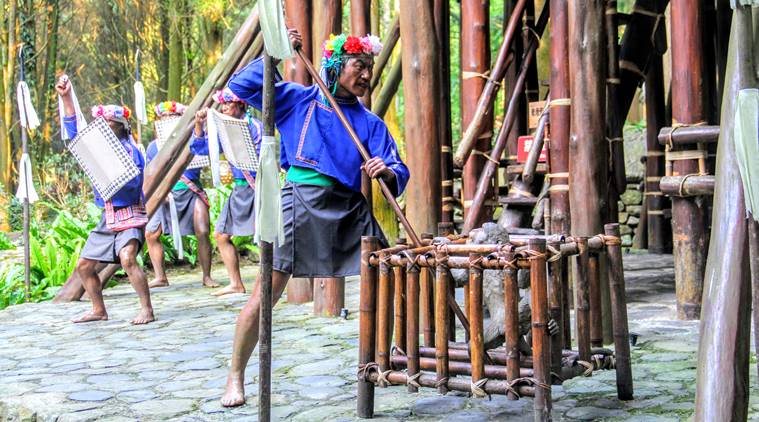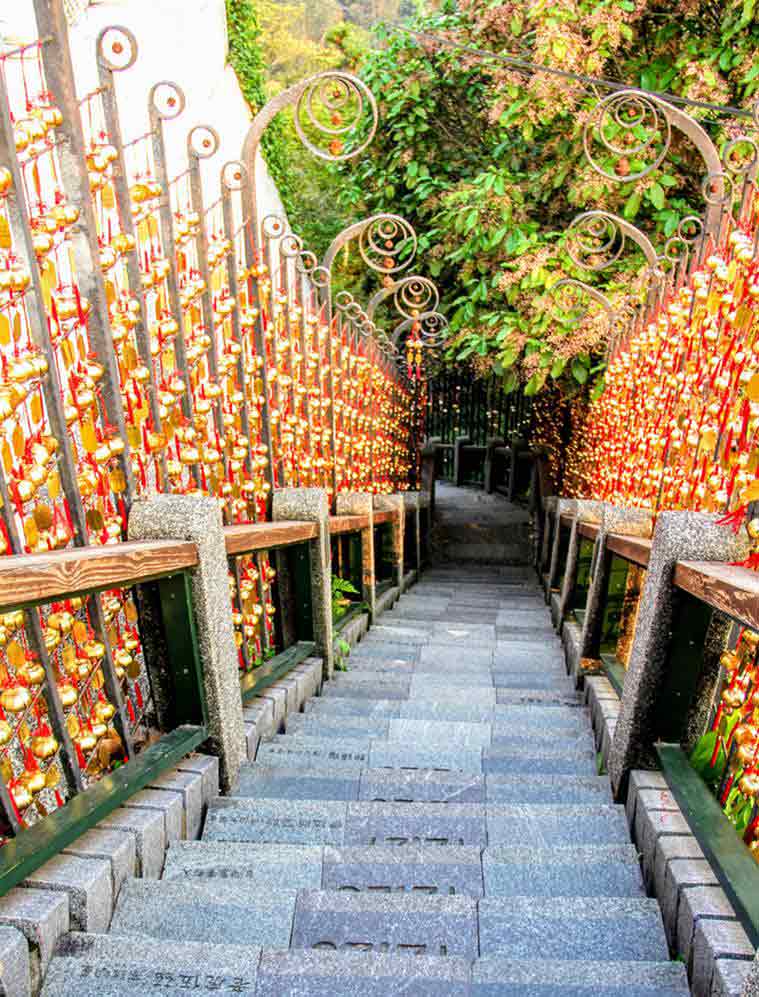
A magnificent glassy sheet of emerald green water ringed by misty mountains, the Sun Moon Lake, located at the foothills of the Central Mountain ranges in Taiwan, reminds me of a delicate Chinese scroll painting. It is circled by a road and a 29-km cycle track which has been rated as “one of the most scenic routes in the world.” Legend has it that a Thao tribal hunter was chasing a white deer through the forest when he arrived at a place of great beauty — a huge expanse of jade-green water rife with fish. He decided to relocate his tribe and settle on the shores of what is now the lake.
In the early 20th century, two separate water bodies formed the lake. The Japanese built a dam for hydroelectric power flooding the area and creating the unique shape — round like the sun on the east and like the crescent moon on the west. The lake became popular in the 1970s because the late President Chiang Kai-shek used it as his favourite vacation spot. Today, his erstwhile summer home is the plush Lalu Hotel, perched on one side of the lake.
I stay at a hotel about three odd km from Lalu Hotel. My first glimpse of the pristine lake is from the balcony of my hotel. The hotel has interiors decorated with orchids, metal sculptures and floor-to-ceiling glass windows that frame the lake like a piece of art. There’s a bonus in every room — a huge marble tub that fills up with natural hot spring water.
Driving around the lake, lined with hundreds of cherry trees, alongside cypress, maples and slender bamboos, we reach the sleek Xiangshan Visitor Information Centre, flanked by landscaped gardens, shaped like a boomerang with two curved arms. Designed by Japanese architect Norihiko Dan, it houses a tourist information centre and cafe and souvenir shop. The minimalistic, organic structure lets nature take centre stage with an infinity pool and the shimmering lake beyond.

One can explore the lake cycling around its perimetre or with a yacht ride from one of the three piers. We take a yacht ride from the Ita Thao Pier, skimming on the glassy waters past old-fashioned fishing nets and floating pontoons. Iridescent dragonflies skim the waters teeming with carp, catfish and shrimps that are a favourite with anglers. In the centre of the lake is Lalu Island, once home to the Thao tribes (the smallest of Taiwan’s indigenous groups), who believe that the maple trees here housed their ancestral spirits.
Small floating islands, with clusters of vegetation, are part of the fishing culture of the lake. They have plankton, and fish and shrimp flock here, getting trapped in the bamboo traps set up by the fishermen. No one can swim in the lake, except at the time of the Sun Moon Lake Swimming Carnival in early September, when about 10,000 swimmers from the country and abroad take to the waters for the annual two miles across the lake swim. The lake is surrounded by scenic hiking trails, exotic flora and colourful local temples. Shops sell souvenirs in the shape of owls made from ceramic, wood and metal — it’s a motif revered by the local Thao tribes and harks back to a legend of a pregnant girl shunned by her people.

For a bird’s eye view of the lake, we take the ropeway cable car service to the Formosan Aboriginal Village — it is a panoramic ride that lifts us between two peaks, ascending and then plunging, with the rope creating a smiley sign, giving it the name, Smiley Valley. Far away, the lake glistens and the luscious greenery envelopes us — ferns, Chinese firs and maples. Even the cheery colours of the cable cars are symbolic, representing the sun, the moon, the lake and the forest.
At the top is the gargantuan Aboriginal village, a mix of theme park and cultural village sprawling over 62 hectares. “Taiwan has 16 officially recognised tribes, 11 of whom are represented here,” explains our guide, dressed in a vibrant tribal costume with a wreath of flowers on her head. “These tribes belong to what is referred to as the Austronesian population connected to Polynesians and Maoris as well as the people of Micronesia,” the guide adds.
We walk through tree-lined paths, passing ceremonial poles, different replica homes of tribes like Rukai, Puyuma and Pawan, built with attention to details — from their furnishings to the natural materials used. At the front of one hut is an eerie display of replica skulls; most of the tribes were headhunters in the past. The Aboriginal Museum gives us an insight into the lifestyle and culture of the different tribes, displaying huge blocks of weathered wood carved with different signs, ornate headpieces, and brilliant fabrics woven by tribal women, glass beads and chunky silver jewellery.
On the slopes of the misty mountains surrounding the lake, tea is cultivated. It was brought in from Assam during the Japanese occupation. The red tea, Taiwan Tea No 18, is today the signature tea of the region. In the small touristy towns around the lake, vendors sell deep-fried shrimps and special tea eggs — eggs simmered in tea and spices. The lake is also a great favourite with newly married couples who get their photoshoots done at scenic spots around the lake.
At sunset, as the sky turns a blushing pink, we drive up to Wenwu temple, dedicated to Confucius and the gods of literature and war. Guarded by gargantuan stone lions, this temple, with carved tiers of tigers and dragons, had to be reached long ago by a series of 366 steps, dubbed as the “stairway to heaven”. Today, those steps are inscribed with the days of the year, with each corresponding to a Chinese or international celebrity. On the handrails are delicate wind chimes, with blessings tied by pilgrims down the ages.
Come night, the lake becomes tranquil as tourists leave the area, and twinkles of fluorescent lights rise above the forests and lake; I am there in the firefly season and there are trails that one can do at night to enjoy this spectacle. As the inky darkness blankets the mountains and the lake, the silence is overpowering.